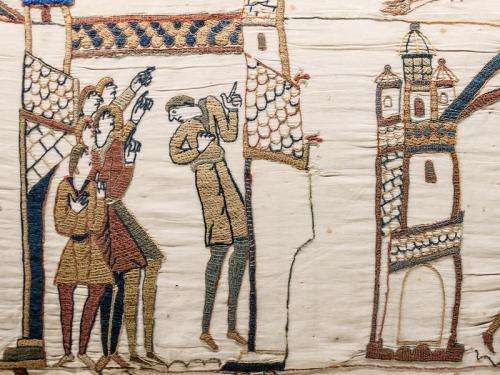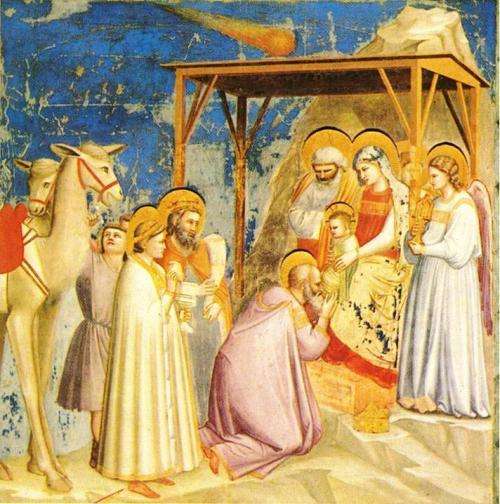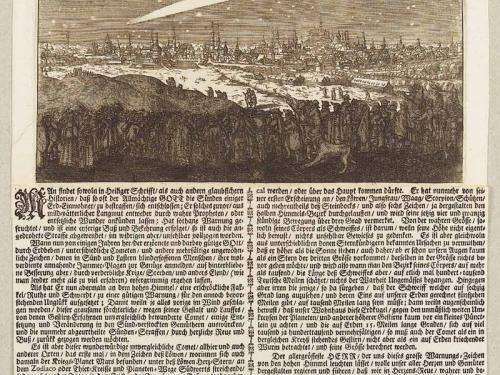Comets play a role in the history of civilization

The sight of a bright comet has fascinated humankind through the ages. But what's behind such celestial spectacles? It's only in modern times that researchers have got wise to the phenomenon - by then, the comets already had a long career as harbingers of bad tidings or heavenly messengers.
The first observations of comets originate from the third millennium before Christ. In ancient cultures, their sudden appearance was considered to a sign from the gods. And because they disturbed the harmony of the starry sky, they were soon deemed to be a bad omen. In ancient Greece the natural philosophers attempted to find an explanation for the phenomenon. Aristotle (384 to 322 B.C.), whose views were to dominate the astronomical and physical worldview in the West for more than one-and-a-half millennia, believed they were emanations of the Earth's atmosphere.
In the Middle Ages, the fear of this "heavy hand of God" reached its pinnacle; comets were thought to portend terrible natural phenomena, such as floods or earthquakes. In the 16th and early 17 centuries, they became a favourite subject for broadsheets, the forerunners of newspapers. A poem from the 15th century provides an impressive description of the nature of comets: "They bring fever, illness, pestilence and death, difficult times, shortages and times of great famine."
The tailed stars also found their way into art and were depicted, for example, in the famous Bayeux Tapestry, which shows the conquest of England by William of Normandy in 1066. Or in a fresco by the Italian Renaissance painter Giotto di Bondone in the Cappella degli Scrovegni in Padua (1304). Both portrayals were inspired by the appearance of the famous Halley's Comet, and Giotto's fresco "Adoration of the Magi" gave rise to the still widespread belief that the Star of Bethlehem was actually a comet.
"Comet fever" is still rife today: when Halley's Comet appeared in the sky in 1910 as expected, many feared that civilization would be poisoned by prussic acid, which had recently been discovered to be a component of the tail. Clever wheeler-dealers sold comet pills to ward off this eventuality. And when the Hale-Bopp comet gave an impressive performance in the terrestrial sky in 1997, 39 members of the Heaven's Gate sect committed suicide because they believed it would enable them to leave Earth and travel to an alien space ship, which was supposedly accompanying Hale-Bopp.
Astronomical research on comets was slow in starting. Nevertheless, Peter Apian from Ingolstadt (really Peter Bienewitz, 1495 to 1552) was the first astronomer of modern times to observe that the tails of comets always point away from the Sun. Apian describes this in his book Astronomicum Caesareum, which was published in 1540 and dedicated to Emperor Charles V.

A few decades later, the Danish astronomer Tycho Brahe (1546 to 1601) recognised that comets were independent celestial bodies: he measured the parallax of the bright comet of 1577 and thereby determined its distance to be around 230 Earth radii, corresponding to 1.5 million kilometres. This conclusively refuted the teachings of Aristotle that comets were phenomena within the terrestrial atmosphere. Comets even turned out to be translunar objects, meaning they stayed beyond the Moon.
But on which trajectory did comets travel through space? This also kept researchers puzzled for a long while. Tycho Brahe was the first to believe that comets returned periodically. The famous astronomer Johannes Kepler (1571 to 1630), on the other hand, thought the trajectories were straight lines - and thus contradicted his own laws which assigned elliptical orbits to the planets!
Johannes Hevelius (1611 to 1687), a Danzig alderman and astronomer, believed – correctly, as we now know - in elongated parabolas and hyperbolas. The dispute about the correct form of the trajectory adorns the title page of Hevelius' Cometographia. The book was published in 1665 and also addressed the appearance and form of the comets, and attempted to classify their tails.
In 1680, the 24-year-old Edmond Halley (1656 to 1742) observed a large comet. The friend of Isaac Newton who later became Astronomer Royal tried desperately to have the comet run on a straight trajectory, as Kepler had demanded six decades before. In vain! During a meeting with Newton, Halley explained that the comet of 1680 probably had a "sharply curved" trajectory.
With this finding, Edmond Halley made new calculations and came to the result that the comet apparently travels on an elongated ellipse and should return in 1758. Halley died in 1742 and so did not live to see his triumph of celestial mechanics: because on the evening of 25 December 1758, the Saxon farmer and amateur astronomer Johann Georg Palitzsch (1723 to 1788) discovered a weak spot of light in the Pisces constellation ..... The comet, known as Halley's Comet, returns into the inner solar system and thus near to Earth every 76 years, the last time being in 1985/86.
This clarified the form of the comet's trajectory. But where do they come from? And what causes these occasionally magnificent phenomena? In 1950, the Dutch astronomer Jan Hendrik Oort (1900 to 1992) suspected that the long-period comets originate from a reservoir that envelops our planetary system like a shell at a distance of up to 1.6 light years. In addition to this Oort Cloud, which has not yet been confirmed by observation - the Estonian astronomer Ernst Öpik had already guessed at a similar object back in 1932 - there obviously exists yet another home for medium-period comets - the Kuiper belt.
Out there, at the edge of the solar system, possibly 100 billion frozen lumps of ice and rock with diameters ranging from a few metres to around 100 kilometres are drifting around. These are the nuclei of the comets. The European Giotto space probe was the first to take a close-up photo of such a nucleus as it flew past Halley's Comet at a distance of just under 600 kilometres.

The photos showed a cosmic peanut measuring approximately 15 by 6 kilometres which was extremely dark and covered by a dust layer with low albedo. Plumes of evaporating ice were evident only at a few distinct places. The material, mixed with dust, had a high proportion of organic compounds - including amino acids, which are an essential component of life on Earth. In addition, Halley lost around 60 tonnes of water vapour per second.
Later missions to other comets - to Wild 2, for example - confirmed this impression: the pictures always show crater-covered "space potatoes" from whose surface material is ejected into space. This material originates from the time when the planetary system was born 4.5 billion years ago and is practically unchanged thanks to the freezing. Comets are therefore welcome messengers from the past.
Let's accompany one of these dirty snowballs that was catapulted out of the Oort Cloud on its journey towards the Sun. As the distance decreases, the temperature increases. The comet gases vaporise and form an extended, thin atmosphere: the coma. This reaches a diameter of several 100,000 kilometres. The comet is now nearly at the level of Saturn's orbit and can be discovered from Earth.
Finally, a tail forms - the characteristic attribute of a comet. The cause is the solar wind - a flow of electrically charged particles - which the Sun permanently blows into space with a speed of 400 kilometres per second on average. The tail flutters in space like a windsock and thus always points away from the Sun. Comets can have tail lengths of several 100 million kilometres.
Photos of bright comets, such as Hale-Bopp for instance, show that there are basically two different types of tail: the straight gas or plasma tail with a blue glow, and the frequently fanned-out dust tail with a yellow shimmer; the latter is caused mainly by the light pressure of the solar radiation. Occasionally, some comets have an anti-tail as well, which is illuminated space rubble that the comet deposits along its trajectory and that appears for a short time as a bright line under favourable light and projection conditions.
The space rubble consists of very fine particles, and larger rocks as well, which the solar wind continuously blows out of the comet. As already mentioned, the released comet material spreads out like a "dirt track" in space, as it were. If the Earth passes through such a field of scree, the particles penetrate into the atmosphere and race across the sky as a shooting star.
These could include larger pieces, which do not simply burst during their fiery ride through the terrestrial atmosphere, but fall to Earth as meteorites. And this is where the comets come into play as genuine "harbingers of bad tidings": our planet is, namely, bombarded continuously by cosmic bullets. Crater basins such as the Nördlinger Ries bear witness to the striking of such bombs. The impact of a kilometre-sized hunk from space - a comet nucleus or asteroid - would have catastrophic consequences. ISON represents no danger, however. At the end of December, it will fly past Earth at a reassuring distance of 64 million kilometres.
Provided by Max Planck Society





















